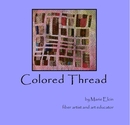Gallery Visit #2: Perelman Building PMA, "Common Ground: Eight Philadelphia Photographers in the 1960's and 1970's"
I'd originally been planning to visit and write about the Kantha exhibit (see previous post), and normally I would have walked right by a photography exhibit. However, I'm glad I entered, as hidden behind the room barriers, unseen from the entranceway were 2 photographic fiber pieces by artist Catherine Jansen. A quick internet search revealed her website, where she claims to be one of the first artists to use digital imaging in fine art. Both of the works in this exhibit span her early career as an emerging artist, and I was intrigued to note that she received her MFA from Tyler (where I'm currently a graduate student).
 At the right side of the exhibit, her piece "Self-Portrait" from 1971, is a cyanotype-printed image combining a photogram body print, photogrammed feathers, grid texture, grasses, and ferns, as well as 2 negative-printed self-portraits and 2 negative-printed stereogram views of Niagara Falls. Randomly placed indigo patches may cover up images or areas that didn't print well, and 2 patches that abut the main figure may even erase parts of her body, like bulges under the arm and along the back. Embroidery stitches define the frames of the stereograms, and french knots are scattered like seeds in one boxy area. However, this stitching and quilting is minimal and the work suffers for the uneven stitching as there are unintentional wrinkles and uneven surface tension.
At the right side of the exhibit, her piece "Self-Portrait" from 1971, is a cyanotype-printed image combining a photogram body print, photogrammed feathers, grid texture, grasses, and ferns, as well as 2 negative-printed self-portraits and 2 negative-printed stereogram views of Niagara Falls. Randomly placed indigo patches may cover up images or areas that didn't print well, and 2 patches that abut the main figure may even erase parts of her body, like bulges under the arm and along the back. Embroidery stitches define the frames of the stereograms, and french knots are scattered like seeds in one boxy area. However, this stitching and quilting is minimal and the work suffers for the uneven stitching as there are unintentional wrinkles and uneven surface tension.The beauty of the piece is more in her exploration of self-portraiture rather than her craftsmanship. It is not a mere photographic representation of her features, but is a combination of elements that clue the viewer in to Jansen's emotions and personal history. The bed-like scale and laying figure coupled with the 2 negative-printed portraits showing her hands in alternate poses of choking and submission make this piece tread an uneasy balance between dreamscape and nightmare. After looking her through her website, it appears that this cyanotype bed-like imagery led her into creating an entire room reproduction in cyanotype, which fed into an entire 5-room installation from which the following piece is taken.
 This diorama at the left of the gallery reveals Jansen's sculptural background. Entitled "Tabletop Arrangement" from the "Soft House Project (Domestic Landscape)" created in 1979-1980, Jansen has photographed to scale multiple household objects, printed them on fabric via color photocopying, and reconstructed the objects in 3-dimensional stuffed forms. A floor mat, Burpee seed catalog, and Chinese slippers lay in front of a tablecloth-draped demi-table upon which are set a vase of flowers, a pair of secateurs, framed girlhood photos, an air-mail letter, a polaroid camera, and a stack of polaroid prints. Beside the table is a wastebasket filled to the brim with the packaging detritus of the polaroid picture-taking (all still printed, sewn, and stuffed objects!). Behind these is a backdrop recreating the floral wallpaper, baseboards, framed and hung photographs, and a large 6-pane window revealing a view of a fantastically fecund landscape.
This diorama at the left of the gallery reveals Jansen's sculptural background. Entitled "Tabletop Arrangement" from the "Soft House Project (Domestic Landscape)" created in 1979-1980, Jansen has photographed to scale multiple household objects, printed them on fabric via color photocopying, and reconstructed the objects in 3-dimensional stuffed forms. A floor mat, Burpee seed catalog, and Chinese slippers lay in front of a tablecloth-draped demi-table upon which are set a vase of flowers, a pair of secateurs, framed girlhood photos, an air-mail letter, a polaroid camera, and a stack of polaroid prints. Beside the table is a wastebasket filled to the brim with the packaging detritus of the polaroid picture-taking (all still printed, sewn, and stuffed objects!). Behind these is a backdrop recreating the floral wallpaper, baseboards, framed and hung photographs, and a large 6-pane window revealing a view of a fantastically fecund landscape. While the self-portrait in cyanotype was more literal, this installation (just a small part of a 5-room installation) is showing more of the day-today life of the artist, her family, and her imagination. The things we own speak volumes about us. The intense florals, the explosive gardenscape, and the seed catalog, seed packets, secateurs, and "fresh-cut" flowers reveal her green thumb, or her desire to have one. The polaroids share her passion for photography, but also allow us a peek into her family life. The multiple views through the windows and photographs give the viewer various entry points into myriad worlds. It's an Alberti's window with pictures within pictures within pictures. Although this piece, too, lacks needlework finesse, it's easier to overlook in the installation than in the cyanotype as Jansen gives us so much more to look at. I feel as if I could look for hours and still be lost in patterns and windows and memories.
There were a lot more photographs in this exhibit, but I only had eyes for fiber.




No comments:
Post a Comment